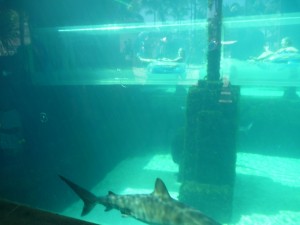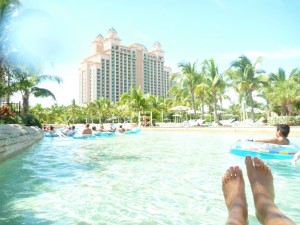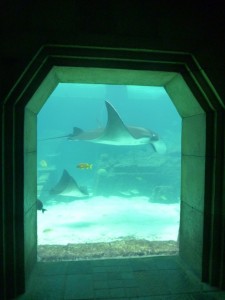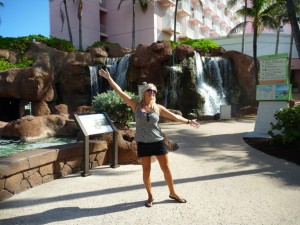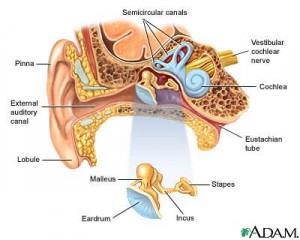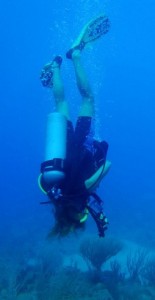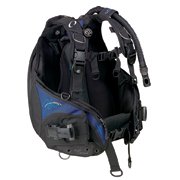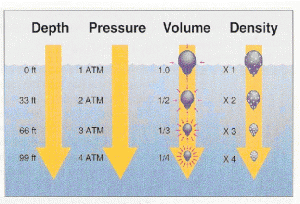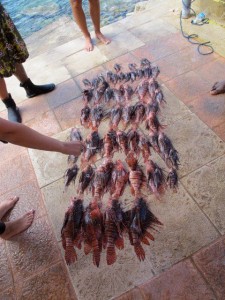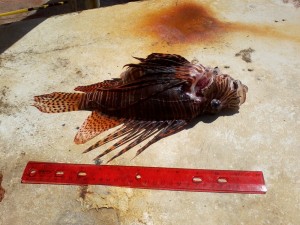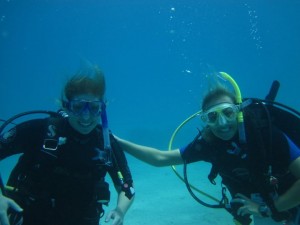In September 2012, I spent 3 days at the famous Paradise Island, Atlantis Resort in the Bahamas. This is a unique hotel resort experience because it consists not only of the lavishness commonly found in this type of setting with stunning rooms, amenities, beaches, restaurants, and views; however, the Atlantis Resort stands out among its peers due to the fact that it also includes an extensive aquatic theme park which is included within the price of the stay of the hotel. 20 million gallons of water, 141 acres, 11 pools, 8 waterslides and 2 river tubing rides alongside aquarium glass tunnels, open lagoons filled with animals, and floor to ceiling windows featuring Reef Sharks, Manta Rays, Nassau Groupers, Jelly Fish, Lobster, and one of the most famous Bahamian animals the Conch!
From all of the countless features of this resort, I decided to focus on the Aquaventures water park. And being the funny girl I am – strangely attracted to the thrilling, but ultimately satisfied with easy-going rides, here are my personal insights into each waterslide!
There are 2 areas in the Aquaventure water park with each section being home to 4 different waterslides. To access the waterslides, you will need to find a Towel Hut and swipe your room key, so they can give you a bracelet. My best advice, with regards to any pre-waterslide preparation, is to leave all money, watches, jewellery and anything of value in your room, otherwise you will have no choice but to leave it on a poolside lounger or rent a locker for a minimum of 7USD/day while you romp and play in the water.
The first water playground we encountered was at The Mayan Temple. There you will find 4 fun waterslides, one of which (and my personal favourite), requires a tube that you get prior to climbing the stairs to the top. The Serpent takes you through an enclosed chute, first into darkness, then from side to side and finally down through a transparent tube. The coolest part is that it runs straight through a huge aquarium full of sharks you can see from the safety of the ride and then tosses you out on the other side! Fun!
The other 2 slides at the top of The Mayan Temple are for true thrill seekers. You can choose between the super speedy 60 foot drop at a virtual 90 degree angle down on The Leap of Faith or The Challenger, which you and your friend can race down side by side to see who goes the fastest or the farthest with a heart-stirring bounce part way through! Both are open air slides.
The other slide on The Mayan Temple is called The Jungle and I would call a more traditional style of slide. It is open air and swishes you from side to side through mountainous terrain and drops you into a lovely pool of water. This would be the tamer of the four slides, but still ignites a squeal of laughter or two along the way!
After The Mayan Temple why not make your way over towards The Power Tower, which is home to a great mile long tube ride called The Current. The highlight of this river ride would definitely be the waves that rush you along as well as the route towards the end (stay to the left!) called “The Rapids”, which tumble and spin you every which way. If you veer to the right instead, you will get the opportunity to do one of 2 super fun water slides with your tube, either The Drop or The Falls. You will be directed onto a big elevator that will click clack your way to the top. I tried The Drop and enjoyed the thrilling plummet and butterflies as I was sloshed about the tunnel!
The most exciting, thrilling, and scary waterslide, in my opinion, is atop The Power Tower and called The Abyss! Even just climbing to the top is worth the 360 degree view of the ocean and resort, but don’t be surprised (or deterred!) if you hear both men and women scream as they drop down the dark tunnel. Because the drop straight down at top speed with rushing water beneath you couldn’t be intense enough, why not ensure you are surrounded by pitch blackness! Eeeek! However, my favourite part of The Abyss is the ending (oddly enough) when it spits you out into a cave with 2 beautiful aquariums built into the walls – very cool! Now, for a different kind of thrill, take a tube all the way back to the top of The Power Tower and enjoy a wild outdoor drop down The Surge and then twisty-swirly fun through rapids along the way! Make sure you do what they tell you and don’t drag your bum and watch your toes as your tube gets bounced around!
If waterslides are not your calling, I would like to highly recommend a fascinating presentation of the mythical civilization called Atlantis that, according to Plato, was destroyed by earthquakes and a tidal wave and rests below the surface of the ocean some 11 000 years ago! Leisurely stroll through The Dig and enjoy this stunning aquarium; view the giant Manta Rays gracefully “fly” by or admire the striking Spotted Eagle Rays with their unique expressions and impressive formations. You will also never forget the extraordinary Green Morays mouthing underwater words to you, the scrawling Lobster tank, and magnificent swimming Sea Horses and more!
All in all, I had a great time exploring even just a fraction of what Atlantis has to offer. The only thing I found challenging was affordable eating and drinking options since the resort is not, in fact, a traditional all-inclusive. You can make use of the convenience store across the street to purchase things like water, snacks, and alcoholic beverages to help with this.
I thoroughly enjoyed the Atlantis Aquaventure water park and all of its amazing animal creatures. This is well worth a fun-filled day pass and a cool add-on feature at a luxury resort!

